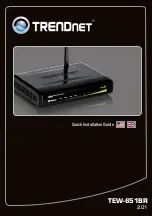
twisted pair wire).
On the other hand, wireless networks do not use wires; instead they
communicate over radio waves. Each computer must have a Network Interface Card
(NIC)
,
which communicates the data between computers. A NIC is usually a 10Mbps network card, or
10/100Mbps network card, or a wireless network card.
Most networks use hardware devices such as hubs or switches that each cable can be connected
to in order to continue the connection between computers. A hub simply takes any data arriving
through each port and forwards the data to all other ports. A switch is more sophisticated, in that
a switch can determine the destination port for a specific piece of data. A switch minimizes
network traffic overhead and speeds up the communication over a network.
•
Router
A router is a device that forwards data packets from a source to a destination. Routers forward
data packets using IP addresses and not a MAC address. A router will forward data from the
Internet to a particular computer on your LAN. A router also determines the best route that data
packets should follow to ensure that the data packets are delivered properly.
•
Firewall
A firewall is a device that sits between your computer and the Internet that prevents unauthorized
access to or from your network. A firewall can be a computer using firewall software or a special
piece of hardware built specifically to act as a firewall. In most circumstances, a firewall is used
to prevent unauthorized Internet users from accessing private networks or corporate LAN's and
Intranets.
A firewall watches all of the information moving to and from your network and analyzes each
piece of data. Each piece of data is checked against a set of criteria that the administrator
configures. If any data does not meet the criteria, that data is blocked and discarded. If the data
meets the criteria, the data is passed through. This method is called packet filtering.
A firewall can also run specific security functions based on the type of application or type of port
that is being used. For example, a firewall can be configured to work with an FTP or Telnet
server. Or a firewall can be configured to work with specific UDP or TCP ports to allow certain
applications or games to work properly over the Internet.
•
VPN
–
Virtual Private Network
Virtual Private Networking
(VPN)
uses a publicly wired network
(the Internet)
to securely
connect two different networks as if they were the same network. For example, an employee can
access the corporate network from home using
VPN
, allowing the employee to access files and
printers. Here are several different implementations of
VPN
that can be used.
•
PPTP
– Point-to-Point Tunneling Protocol
PPTP
uses proprietary means of connecting two private networks over the Internet.
PPTP
is a
way of securing the information that is communicated between networks.
PPTP
secures
information by encrypting the data inside of a packet.
42




































